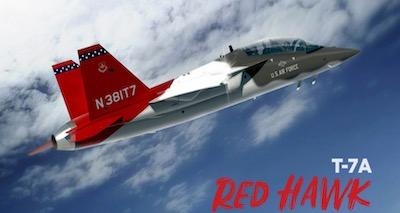Red Hawk Trainer Now Landing Q4 2024
Complications with the ejection seat system of Boeing’s T-7A Red Hawk have delayed delivery of the new advanced jet trainer to its United States Air Force launch customer until the third quarter of 2024.

USAF spokeswoman Major Alexandra Stormer somewhat vaguely attributed the T-7A’s woes to the aircraft’s flight control software and the escape system. “All flight control software issues to date have been resolved and will be tested in flight in the first quarter of 2023,” Maj. Stormer remarked. “The Air Force is working to correct some escape system deficiencies found during initial testing in late 2021, and will resume escape system testing in the first quarter of 2023.”
The T-7A, upon closer examination, appears to have fallen victim to de rigueur Pentagon progressive policies. A 2020 report from McClatchy—a left-wing digital news service describing itself as “truth-teller(s) and protector(s) of independent voices—tacitly impugned the Air Force for basing its aircraft cockpit and cockpit seat dimensions on the average physical measurements of USAF pilots circa 1960 through 1970. The practice—albeit eminently defensible—makes no allowances for heavier male pilots or smaller, less physically powerful, occasionally pregnant female pilots. Ergo, the T-7A was designed to be more accommodating of different body sizes encompassing all pilots capable of meeting Air Force standards—which, in recent years, have been substantially relaxed.
Ensuring the T-7A’s ejection system is capable of reliably blasting portly aviators and expectant mothers into the baleful blast Mach 1.0 relative winds and murderous barometric differentials has proved challenging, however.
The Air Force announced in October 2021 that it had started testing the T-7’s ejection system, setting forth in a press release that its evaluations comprised “the largest-class and smallest-class manikins”—thereby taking into account the broad range of body types around which the jet is designed.
Regrettably, the U.S. Government Accountability Office’s 2021 Weapon Systems Annual Assessment flagged qualification of the T-7A’s ejection system as one of two primary risks to the program’s schedule. The GAO’s 2022 report called the Red Hawk’s ejection system a top program risk. “If the program experiences delays in qualifying the emergency escape system, there is increased risk of delay to the November 2023 production decision,” the report stated.

In addition to shortcomings with its body-positive ejection system, Air Force testing of the T-7A revealed a degree of aircraft wing rock—an unwanted self-induced rolling oscillation alternately attributable to wing planform, fuselage cross-section, and vertical stabilizer design.
Boeing, at present, is working with the Air Force to re-baseline the T-7A delivery schedule. Boeing spokeswoman Mary Ann Brett asserted: “… The program is accomplishing new milestones as the pathfinder program for a digitally designed, built and tested system. … Boeing plans to complete all supporting activities by [the third quarter of] 2024.”
Notwithstanding the complications and delays with which the T-7A program is currently contending, the Air Force and Boeing remain steadfast in their shared conviction to apply the digital design and simulation processes by which the Red Hawk was conceived of and actualized to future aircraft programs.
 Bolen Gives Congress a Rare Thumbs-Up
Bolen Gives Congress a Rare Thumbs-Up The SportPlane Resource Guide RETURNS!!!!
The SportPlane Resource Guide RETURNS!!!! Buying Sprees Continue: Textron eAviation Takes On Amazilia Aerospace
Buying Sprees Continue: Textron eAviation Takes On Amazilia Aerospace Hawker 4000 Bizjets Gain Nav System, Data Link STC
Hawker 4000 Bizjets Gain Nav System, Data Link STC Echodyne Gets BVLOS Waiver for AiRanger Aircraft
Echodyne Gets BVLOS Waiver for AiRanger Aircraft




